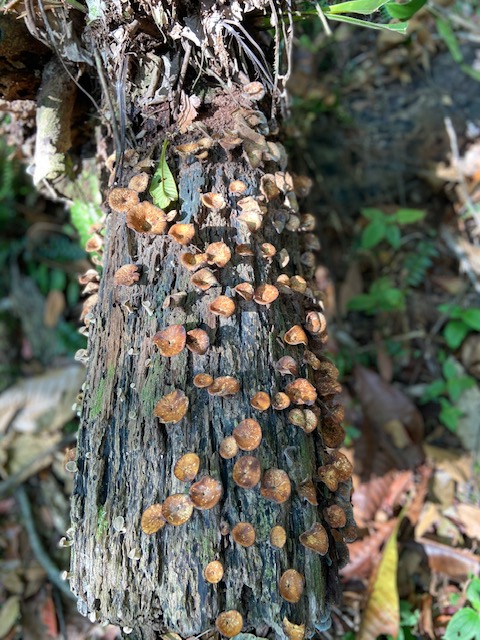The whirlwind of repeated introductions gave way to earnest conversations over zoom. The fervour of speed dating continued as we met every few days over Zoom with dedicated facilitators who patiently held space for us as we skimmed the surface then dived into the waters of the virtual world of learning and teaching.
Concepts of digital literacies and Pretsky’s natives and immigrants were juxtaposed against David White’s persuasive visitors and residents.
My response to the question of who I am as an individual in the digital age did not require too much thought! Easy. I had always been an uneasy visitor. Suspicious of another reality when life already held so much to juggle with, shadows and light and sometimes difficult terrain and the drudgery of the routine.
2020 marked a change when I stepped out with a vision to do something for the many staff in my hospital and the other institutions under the umbrella of NUHS to counter the relentless tide of Covid 19 which seemed to engulf the whole world. The disruption to everyone’s usual way of doing things would wear us down. The concept of Open Spaces was born as I wondered what could be done to nourish, sustain and strengthen our people?
I dreamt of creating a cosy area where staff could come for a nice drink and some time out of their busyness, looking at something far removed from our usual workplaces. A short stroll with a drink in hand, soft music playing in the background and some panoramic scenes to gaze at. Perhaps a chance to sit down and write a few thoughts to share with others. For the more creative, write a poem or share a drawing or photograph.
Then social distancing started so Open Spaces had to be virtual. https://fb.watch/4jL5XgvOUw/
The motivation to do something in response to widespread burnout and moral distress pushed me out of my comfort zone. The alien world of Instagram opened up as I created my digital identity through my personal Instagram account to access Open Spaces. Although the boundaries between my personal and professional life were blurred as I shared photos, quotes or thoughts that I found meaningful on the Open Spaces platform, I did not venture into my personal Instagram account to connect with friends or colleagues who were on Instagram.
I spoke with friends and colleagues to encourage them to share on Open Spaces. This was harder for some than others.
Maintaining that professional façade is what we are taught to do in our medical careers. When is it safe to reveal more about oneself in the workplace?
I watched the movie, The Social Connection recently, after embarking on ONL 211. For those who haven’t seen it, it tells the story of Marc Zuckerman and how Facebook came into being, after a breakup. In his quest for ‘the’ girl he stumbled upon the motivation of Harvard students and indeed all university students when he created Facemash in one emotionally charged night.
Connecting as we have and with the time pressure to deliver our combined presentation for this topic, I now gather my thoughts after watching various youtube videoclips and reading snippets. I am in a liminal space.
 Light filtering through bamboo at the Mandai Trail. The liminal space is the “crossing over” space, a space where I have left something behind, yet I am not fully in something else.
Light filtering through bamboo at the Mandai Trail. The liminal space is the “crossing over” space, a space where I have left something behind, yet I am not fully in something else.
Who knows how long it will take for me to assimilate into the virtual world? My foray with Open Spaces in the second half of 2020 was wonderful but Open Spaces needs to evolve. Embarking on ONL211 is symbolic of crossing a threshold (1). As I pass through the ONL211 portal, I look forward to transformative learning that enables me to interface more fluently and teach in better ways.
 The portal at Kranji War Memorial- the view as I leave.
The portal at Kranji War Memorial- the view as I leave.
 Saprophytes- life from death
Saprophytes- life from death
Scaffolding my learning (2) the way it has been crafted in ONL211 is an integrative experience. Wood, Bruner, and Ross (2), define scaffold, as applied to learning situations, as a process “that enables a child or novice to solve a task or achieve a goal that would be beyond his unassisted efforts”. Greenfield (3) listed the five characteristics of the scaffold as it is known in building construction: it provides a support; it functions as a tool; it extends the range of the worker; it allows a worker to accomplish a task not otherwise possible; and it is used to selectively aid the worker where needed. Dixon, Carnine, and Kameenui (4) remind us that effective scaffolds must be “gradually dismantled” in order to remain effective. Let’s see how I progress in the next few months as the scaffolding supports me.
 An unexpected vine, as if from heaven
An unexpected vine, as if from heaven
References:
1. Meyer, J., & Land, R. (2003). Threshold concepts and troublesome knowledge: Linkages to ways of thinking and practising within the disciplines (pp. 412-424). Edinburgh: University of Edinburgh
2. Wood, D., Bruner, J. S., & Ross, G. (1976). The role of tutoring in problem solving. Child Psychology & Psychiatry & Allied Disciplines, 17(2), 89–100. https://doi.org/10.1111/j.1469-7610.1976.tb00381.x
3. Greenfield, P. M. (1999). Historical change and cognitive change: A two-decade follow-up study in Zinacantan, a Maya community in Chiapas, Mexico. Mind, Culture, and Activity, 6, 92–98. Guzdial, M., Hübscher, R., Nagel, K., Newstetter, W., Puntambekar, S.
4. Robert C. Dixon, Doug Carnine and Ed Kameenui (1993) Tools for Teaching Diverse Learners/Using Scaffolding to Teach Writing.